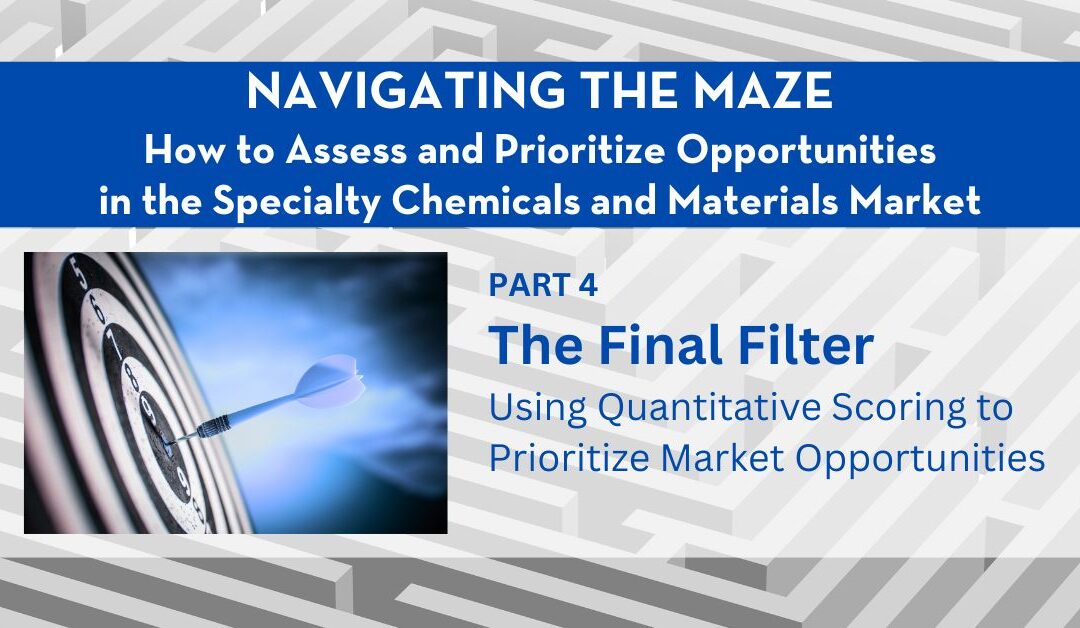Table of Contents
You’ve assembled your interdisciplinary team, assessed market attractiveness and commercial feasibility, and validated technical and manufacturing readiness. Now comes the final step: prioritizing opportunities. When your list of promising projects exceeds your capacity to pursue them all, a structured scoring system ensures objective, data-driven decision making.
In this post, we’ll explore how to build and implement a quantitative framework to evaluate and rank opportunities. This final filter brings discipline to strategy execution, ensuring that your organization invests in the right innovations with the highest potential for return.
Why a Scoring System Matters
Without a scoring model, opportunity assessment often defaults to opinion-driven discussions. The loudest voice in the room — or the trendiest technology — can drive decisions, even when they don’t align with your core strengths or market strategy.
A quantitative scoring system reduces bias and brings transparency and consistency to the process. It allows teams to:
- Compare different opportunities on common criteria
- Align around strategic priorities
- Focus on high-value projects with acceptable risk profile
- Document rationale for decisions (especially useful for leadership reviews)
Step 1: Define Evaluation Criteria
Begin by identifying key dimensions that reflect your business goals. Common criteria include:
- Market size and growth: What is the revenue potential?
- Competitive differentiation: Can you win in the space?
- Customer demand: Is there unmet need or pull?
- Technical feasibility: Is development within your capability and risk tolerance?
- Manufacturing readiness: Can you scale production reliably and affordably?
- Strategic fit: Does it align with your brand, channels, or portfolio direction?
- Time to revenue: How quickly will returns be realized?
Each criterion should be clearly defined so that different evaluators interpret them consistently.
Step 2: Assign Weights
Not all criteria are equally important. Assign weights to reflect your strategic priorities. For example, a growth-stage business might weigh “Time to Revenue” and “Market Size” more heavily. An innovation-driven firm might emphasize “Technical Differentiation” and “IP Potential.”
Here’s a sample weighting:
- Market Size/Growth: 20%
- Competitive Advantage: 15%
- Customer Pull: 15%
- Technical Feasibility: 15%
- Manufacturing Readiness: 10%
- Strategic Fit: 15%
- Time to Revenue: 10%
Step 3: Score Each Opportunity
Rate each project on a consistent scale (e.g., 1 to 5 or 1 to 10) for each criterion. Be rigorous but fair. Involve representatives from each function to ensure a balanced view, and use data wherever possible (e.g., VOC, benchmarks, cost estimates).
Multiply each score by its weight and sum the totals. This process produces a final weighted score that can be used to rank projects.
Example: Prioritizing Two Coating Concepts
Imagine your team is choosing between two new industrial coatings:
- Option A: Corrosion-resistant epoxy for marine equipment
- Option B: Low-VOC polyurethane for flooring applications
Option A scores high on technical feasibility and manufacturing readiness, but the market is slower-growing and highly competitive. Option B shows strong customer pull and aligns well with ESG trends but requires new raw materials and equipment upgrades for scale-up.
Scoring these options reveals trade-offs, highlighting not only which idea is stronger overall, but which criteria might justify an exception. For example, if Option B better aligns with long-term strategic positioning, you might still move forward despite the scale-up investment.
Download the full
navigating the maze white paper
Step 4: Review, Debate, Decide
Scoring is a decision support tool, not a replacement for judgment. After calculating scores, bring your team together to:
- Review score ranges and sensitivities
- Debate assumptions behind each score
- Consider qualitative insights (e.g., market buzz, customer feedback)
- Finalize your short list
The goal isn’t to remove human input — it’s to elevate the discussion with shared facts.
Bringing It All Together
With a structured scoring system in place, your team can confidently prioritize opportunities that align with your strategy, capabilities, and growth goals. Combined with interdisciplinary input and rigorous assessment across market, technical, commercial, and operational domains, this approach builds a resilient process and pipeline.
In a market as dynamic as specialty chemicals and materials, there’s no shortage of good ideas. But only a disciplined, data-driven process will help you turn ideas into impact faster, smarter, and with greater success.
To learn more, reach out to the author at cmorrison@chemquest.com.
How can we help you? Let’s start talking: https://chemquest.com/lets-start-talking/


